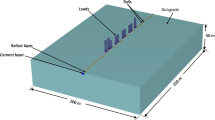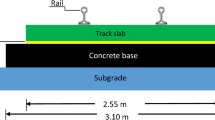Abstract
Instability and settlement of railways constructed on soft soils are among the main concerns of railway engineers. These settlements reduce the quality of the railway and its facilities and lead to financial and life losses. Therefore, several studies have shown the importance of safety in railways constructed over soft ground due to large vibrations caused by high-speed trains, especially under critical speeds. The present study was conducted to investigate the performance of railways on soft soil and the effect of its improvement using geogrid reinforcement layer in the embankment-bed contact. For this purpose, a numerical model was developed in the finite element PLAXIS software ver. 8.6 to investigate the effect of 4 train speeds (20, 80, 140, and 200 km/h) and 5 heights of the embankment (1 to 5 m) on mobilized loads on geogrid, lateral displacement of the embankment, the safety factor of the whole track, and failure surface beneath the track. The results of this study revealed that in loose beds, a large dynamic amplification occurs in ground dynamic response as the train speed reaches a critical speed which was determined in the range of 20 to 80 km/h and found that the maximum mobilized load in geogrid occurs in this speed range.

















Similar content being viewed by others
Change history
16 December 2019
The original version of this article unfortunately contained a mistake.
References
AASHTO.: LRFD Bridge Design Specifications (2017)
AC01895560, A. (ed.): Code of practice for strengthened/reinforced soils and other fills. BSI, London (1995)
Bowles, J.E.: Foundation Analysis and Design (1988)
Celebi, E., Göktepe, F.: Non-linear 2-D FE analysis for the assessment of isolation performance of wave impeding barrier in reduction of railway-induced surface waves. Constr. Build. Mater. 36, 1–13 (2012)
Celebi, E., Kırtel, O.: Non-linear 2-D FE modeling for prediction of screening performance of thin-walled trench barriers in mitigation of train-induced ground vibrations. Constr. Build. Mater. 42, 122–131 (2013)
Correia, A.G., Cunha, J., Marcelino, J., Caldeira, L., Varandas, J., Dimitrovová, Z., Antão, A., Silva, M.: Dynamic analysis of rail track for high speed trains. 2D approach. 5th Intl Worksop on Application of Computational Mechanics on Geotechnical Engineering, 4 (2007). https://doi.org/10.1201/9781439833414.ch39
Das, B.M., Shukla, S.K.: Earth anchors. J Ross Publishing, Florida (2013)
Gao, Y., et al.: High speed railway track dynamic behavior near critical speed. Soil Dyn. Earthq. Eng. 101, 285–294 (2017)
Hussaini, S.K.K., Indraratna, B., Vinod, J.S.: A laboratory investigation to assess the functioning of railway ballast with and without geogrids. Transp. Geotechnics. 6, 45–54 (2016)
Indraratna, B.: 1st proctor lecture of ISSMGE: railroad performance with special reference to ballast and substructure characteristics. Transp. Geotechnics. 7, 74–114 (2016)
Indraratna, B., Khabbaz, H., Salim, W., Christie, D.: Geotechnical properties of ballast and the role of geosynthetics. Institution of Civil Engineers. Proceedings. Ground.... (2006)
Indraratna, B., Nimbalkar, S., Rujikiatkamjorn, C.: From theory to practice in track geomechanics–Australian perspective for synthetic inclusions. Transp. Geotechnics. 1(4), 171–187 (2014)
Krylov, V.V. (ed.): Noise and vibration from high-speed trains. Thomas Telford, London (2001)
Krylov, V.V.: Focusing of ground vibrations generated by high-speed trains travelling at trans-Rayleigh speeds. Soil Dyn. Earthq. Eng. 100, 389–395 (2017)
Leshchinsky, B., Ling, H.I.: Numerical modeling of behavior of railway ballasted structure with geocell confinement. Geotext. Geomembr. 36, 33–43 (2013)
Madshus, C.C., Kaynia, A.: High-speed railway lines on soft ground: dynamic behaviour at critical train speed. J. Sound Vib. 231(3), 689–701 (2000)
Moghadam, M.J., Zad, A., Mehrannia, N., Dastaran, N.: Experimental study on the performance of plate anchor retaining walls. INT J. Phys. Model. Geo. 14;19(3), 128–40 (2018a)
Moghadam, M.J., Zad, A., Mehrannia, N., Dastaran, N.: Experimental evaluation of mechanically stabilized earth walls with recycled crumb rubbers. J. Rock Mech. Geotech. Eng. 10(5), 947–57 (2018b)
Nejati, H.R., Ahmadi, M., Hashemolhosseini, H.: Numerical analysis of ground surface vibration induced by underground train movement. Tunn. Undergr. Space Technol. 29, 1–9 (2012)
Perko, H.A.: Helical piles: a practical guide to design and installation. John Wiley & Sons, Hoboken (2009)
Rimoldi, P.: Design method for railway bases reinforced with geogrid. Adv. Transp. Geotechnics. 2, 46 (2012)
Tatsuoka, F., Tateyama, M., Koseki, J.: Performance of soil retaining walls for railway embankments. Soils Found. 36(Special), 311–324 (1996)
Yang, L.A., Powrie, W., Priest, J.A.: Dynamic stress analysis of a ballasted railway trackbed during train passage. J. Geotech. Geoenviron. 135(5), 680–689 (2009)
Yonezawa, T., et al.: Design and construction of geosynthetic-reinforced soil structures for Hokkaido high-speed train line. Transp. Geotechnics. 1(1), 3–20 (2014)
Zhuang, Y., Wang, K.: Finite element analysis on the dynamic behavior of soil arching effect in the piled embankment. Transp. Geotechnics. 14, 8–21 (2018)
Zoccali, P., Cantisani, G., Loprencipe, G.: Ground-vibrations induced by trains: filled trenches mitigation capacity and length influence. Constr. Build. Mater. 74, 1–8 (2015)
Author information
Authors and Affiliations
Corresponding author
Additional information
Publisher’s Note
Springer Nature remains neutral with regard to jurisdictional claims in published maps and institutional affiliations.
Rights and permissions
About this article
Cite this article
Moghadam, M.J., Ashtari, K. Numerical Analysis of Railways on Soft Soil Under Various Train Speeds. Transp. Infrastruct. Geotech. 7, 103–125 (2020). https://doi.org/10.1007/s40515-019-00092-9
Accepted:
Published:
Issue Date:
DOI: https://doi.org/10.1007/s40515-019-00092-9




